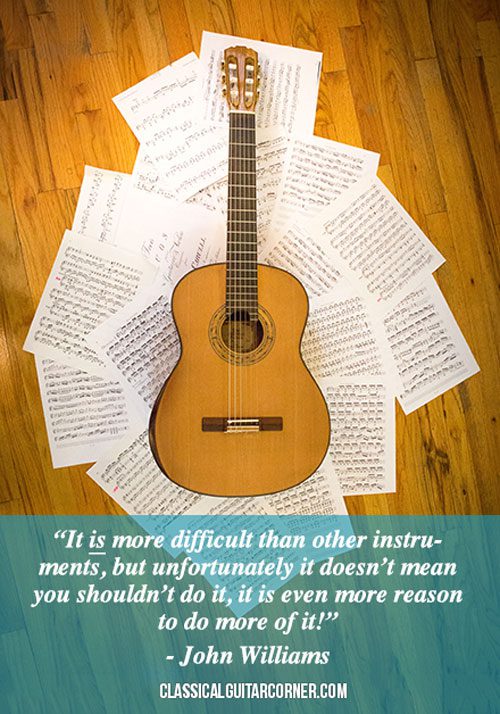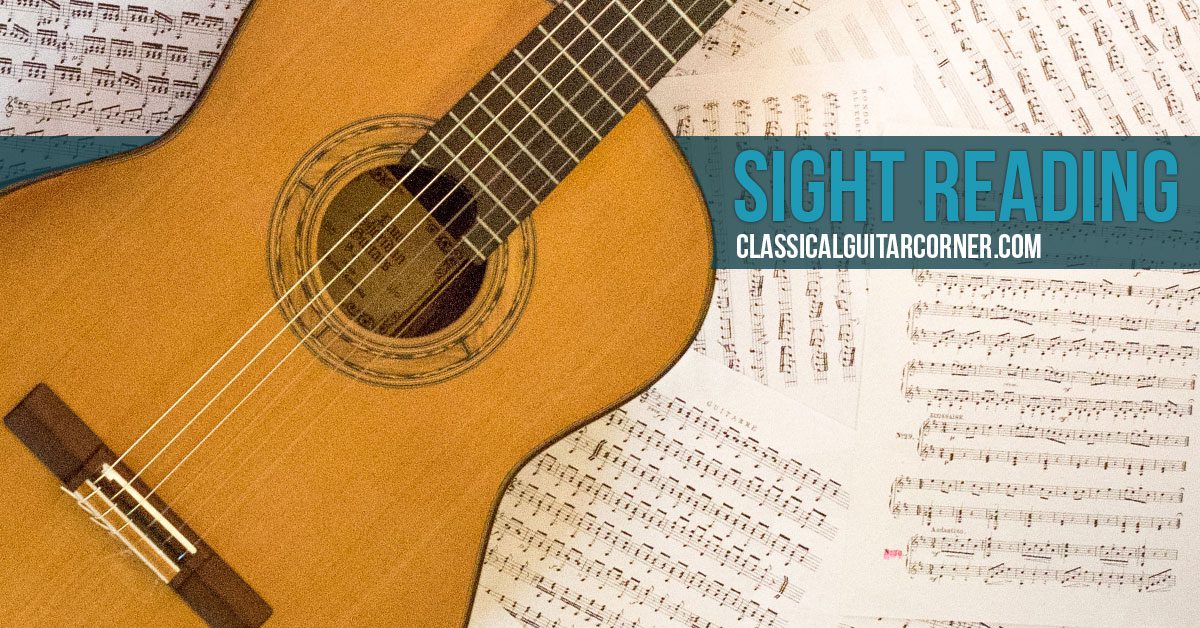Sight-reading on the classical guitar can help you learn pieces faster and explore more music. In this article I am going to give you specific ways that you can improve your sight reading.
But first, let me dispel a couple of myths…
Sight reading on classical guitar is challenging but it is not impossible.
In fact, it is well within your reach.
You might approach the topic with a bit of apprehension as sight reading is often thought of as a very high-end skill that only some possess. Let me tell you right now that you can develop this skill as much as anyone else.
 It is true that the guitar has some specific challenges when it comes to sight reading.
It is true that the guitar has some specific challenges when it comes to sight reading.
- Multiple places to play one note
- Chordal and polyphonic repertoire
- A need for detailed fingering to achieve complex passages
John Williams also acknowledged this inherent truth about the guitar but went on to say that “it is even more reason to do more of it!”
I agree.
On first appearances other instruments might seem to have an easier job at sight reading. However, we must also remember that each instrument has particular challenges.
Pianists, organists, harpsichord… they have up to ten notes at a time (plus feet if you are an organist). Orchestral instruments have to deal with a wide range of key signatures, complex rhythms and fast tempi.
Actually, when you think about it, there are several things that make sight reading on the guitar quite easy:
- Limited key signatures – guitar repertoire is usually in C, G, D, A, E, F Major and b, e, a, and d minor.
- Simple rhythms – compared to what is possible, the majority of classical guitar repertoire uses very simple rhythmic combinations. It is often in one time signature and fairly repetitive.
- Moderate to slow tempi – compared to the speeds a violin and piano can achieve, the classical guitar repertoire rarely requires very fast tempi.
Why then are guitarists so bad at sight-reading?
There are a couple of reasons, and none of them are to do with the instrument.
It is to do with us.
You and I spend a lot of time practicing the classical guitar alone…
This isolation lets us get away without having to sight read. There is nothing to force us into sight reading through materials so we often read it very slowly and memorize it as quickly as possible.
This keeps us stuck at square one.
Also, we predominantly choose solo repertoire which once again gives us the easy out of just taking tons of time to learn a piece, note by note, then committing it to memory. There are no other people looking over our shoulder so why should we sight read?
So, basically, we just don’t ever practice sight reading and the predictable outcome is that we never improve.
On that rare occasion where we get thrown into the uncomfortable position of having to sight read, it can be an embarrassing experience that reinforces the myth that it is difficult.
And so the cycle goes…
Ways you can get better at sight reading on classical guitar
Practice, practice, practice
It really is that simple, like I said in the beginning. Simple yes, but easy no. It requires dedication, planning and effort on your part to practice sight reading on a regular basis.
So how do we practice it?
 By far the best way to improve your reading is by joining an ensemble.
By far the best way to improve your reading is by joining an ensemble.
Another guitarist, a guitar orchestra, a singer, violinist. Just grab anyone who is willing to have a go and jump to it! The reason this is so effective is that it will force you to read on a regular basis. It is this regularity that will have the biggest impact.
Practicing sight reading on your own is a more challenging process because it requires discipline, perseverance and organization.
The organization is often one of the pitfalls in sight reading development. You must choose material that is easy for you. It should be nowhere near the complexity of what you play in your solo repertoire and you should spend some time accumulating materials that are so basic you can read them once or twice with relative ease then move on.
Gathering these materials can take time and can be off putting. To help this I have arranged graded sight reading materials in the CGC Membership. But you can do it on your own.
Violin melodies and flute melodies are great, because they don’t have fingerings. Folk melodies, and even beginner guitar studies (Sor, Giuliani, Carcassi) can be good sight reading fodder.
Specific exercises that will develop your skills quickly
I want to leave you with some actionable ways to improve right now, so here are some exercises with a download sheet below:
Six string scales
Probably the biggest difficulty for people is learning the fretboard in the higher positions, so here are some great ways to force your fingers on an exploratory mission:
Progressions in position
In each of these chord progressions you need to restrict yourself to one position on the guitar. It forces you to become familiar with the notes, chord shapes and there is only one possible solution for each progression…
Passages in different position
Similar to the progressions, this passage can be played in the five different positions indicated. Stick to the span of four frets to challenge your fingerboard knowledge.
All of these exercises, and more are included in your CGC Membership but if you would like to see one of the lessons right now here it is:




An article like this makes me glad I am an annual member of classical Guitar Corner (no I don’t work for Simon :). For a long time I have wanted to improve my sight reading. With CGC I now have a graded and structured approach to improving.